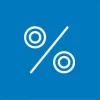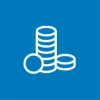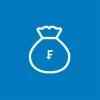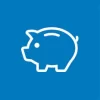How bad or good do Swiss have it compared to savers in other countries? Here, moneyland.ch compares average interest rates in Switzerland with those in a selection of other countries.
Average interest rates for savings by country
Statistics about average interest rates provide a good picture of the overall market for savings products.
This is how average interest rates for Swiss private accounts, savings accounts, and fixed deposits compare to those offered by banks in other countries:
| Product |
Switzerland |
Eurozone |
Japan |
Norway |
United Kingdom |
USA |
| Private accounts |
0.02% |
0.1% |
0.001% |
1.42% |
0.89% |
0.06% |
| Savings accounts |
0.189% |
0.86% |
0.004% |
3.2% |
3.51% |
0.33% |
| Fixed deposits |
1.19% |
1.64% |
0.008% |
3.2% |
3.51% |
0.938% |
The statistics used in this table indicate rates as per January, 2023. Average rates in Switzerland are provided by moneyland.ch. Statistics for other countries are taken from official sources. Rates for fixed deposits are based on a 5-year term.
Highest available interest rates for savings by country
The actual interest rate you get varies depending on which bank you use. It can be much higher or much lower than the average.
These are the highest available interest rates for private accounts, savings accounts, and fixed deposits in March, 2023:
| Product |
Switzerland |
Eurozone |
Japan |
Norway |
United Kingdom |
USA |
| Private accounts |
0.75% |
1.25% |
0.2% |
3.04% |
2% |
2.02% |
| Savings accounts |
1.55% |
2.55% |
0.2% |
3.35% |
4% |
5.02% |
| Fixed deposits |
1.63% |
3.99% |
0.28% |
2.65% |
4.6% |
4.5% |
The rates provided in this table are taken from local financial comparison portals on March 28, 2023. Figures for Switzerland are taken from moneyland.ch comparisons. Note that comparison portals may not account for all banks and offers.
You can find the latest Swiss interest rates using the interactive banking comparisons on moneyland.ch.
Key interest rates
The interest rates offered by commercial banks generally follow the key interest rates set by central banks. However, depending on which bank you use, the interest rates you get may be higher or lower than the central bank interest rates.
Here you can see how the key interest rate of the Swiss National Bank (SNB) compares with those of central banks in other countries:
| |
Switzerland |
Eurozone |
Japan |
Norway |
United Kingdom |
USA |
| Key interest rate |
1.5% |
2% |
-0.1% |
3% |
3.5% |
4.33% |
The key interest rates in this table are accurate as per March 28, 2023.
Inflation rates
The rate of inflation in your country determines the real interest which you earn. Here, you can compare the current inflation rate in Switzerland with those of other countries:
| |
Switzerland |
Eurozone |
Japan |
Norway |
United Kingdom |
USA |
| Inflation rate |
3.4% |
8.5% |
3.3% |
6.3% |
10.4% |
6.04% |
Inflation statistics used in this table are for February, 2023.
To find out how much interest you are really earning in terms of purchasing power, simply subtract the inflation rate from the savings interest rate using the real interest rate calculator on moneyland.ch.
Example:
The average interest rate for Swiss savings accounts is 0.284 percent interest per annum. The inflation rate in Switzerland is 3.4. So the real interest you are earning on your savings is -3.01 percent interest per annum. If you were to use the best available savings account, the real interest rate would be -1.78 percent interest per year.
More on this topic:
How do Swiss income taxes compare to other countries?
How do Swiss credit cards compare to other countries?
Compare Swiss savings accounts now
Compare Swiss private accounts now
Compare Swiss fixed deposits now















